Pool Plastering Maintenance Issues Every Pool Owner Should Know

Owning a swimming pool in sunny Tampa, FL, is a true luxury. Whether you use yours for relaxation, fitness, or entertaining family and friends, it’s crucial to maintain its perfect condition. One of the most critical aspects of pool care is pool plastering, as it affects not only your pool’s appearance but also its functionality.
However, even with the best care, pool plastering can face its own set of maintenance challenges. From preserving its aesthetic appeal to addressing surface damage, understanding common issues is key to enjoying a beautiful, long-lasting pool. This blog will help you identify the most frequent pool plastering problems, explain how to fix them, and show you strategies to prevent them in the future.
And of course, if you're dealing with plastering woes in Tampa, FL, we’re here to help! Keep reading to learn more.
Why Pool Plastering Matters
Pool plastering is the final layer applied to the interior surface of your pool. It provides the smooth texture you feel underfoot and keeps the pool's structure watertight. Typically made from cement-based products mixed with additives like marble sand or quartz, plastering also enhances the pool's visual appeal, giving it that classic blue finish.
But why does it matter so much? Properly applied and maintained plastering plays a significant role in extending the lifespan of your pool and improving your swimming experience. Without it, your pool could encounter issues like water leaks, rough surfaces, and stains that not only diminish its appearance but also lead to bigger problems if left unattended.
Common Pool Plastering Maintenance Issues
Despite all its benefits, plastering isn’t impervious to wear and tear. Here are some of the most common problems pool owners in Tampa, FL, face with their pool plastering and what causes them.
1. Staining
- The Problem: Unsightly stains can develop on your pool’s plaster, ranging from dark discoloration to persistent reddish or bluish patches. Stains are often caused by mineral buildup, algae growth, or chemical imbalances in the water.
- How to Fix It: Minor stains can often be cleaned using specialized pool stain treatments or acid washing. For larger or recurring stains, you may need professional help to resurface or reapply the plaster.
2. Chipping or Etching
- The Problem: Chipping and etching are wear issues where small fragments break off, or the surface begins to feel rough and uneven. This typically occurs due to improper water chemistry (low pH or calcium levels) or poor-quality plastering materials.
- How to Fix It: Addressing water balance is crucial to stop etching in its tracks. If chipping has escalated, resurfacing the affected area might be necessary. Poor plaster mixes should also be replaced by professional-grade products.
3. Cracks
- The Problem: Cracks in your pool plaster can develop over time due to structural settling, ground water pressure shifts, or natural aging. Left unresolved, cracks may worsen and lead to water leaks.
- How to Fix It: Small cracks can often be patched with plaster repair kits. However, larger cracks may require complete resurfacing to restore structural integrity.
4. Rough Surfaces
- The Problem: Over time, improper maintenance can cause your plaster surface to wear down, creating a rough texture that’s uncomfortable for swimmers and damages swimwear.
- How to Fix It: Sanding or acid washing can smooth out minor rough patches. For highly worn areas, fresh plastering or a new finish may be necessary.
5. Discoloration from Pool Chemistry
- The Problem: Improper pool chemical levels can lead to discoloration of the plaster surface. For example, high chlorine levels might bleach plaster, while dissolved metals in water could leave coloring behind.
- How to Fix It: Routinely monitor and balance your pool’s pH, alkalinity, and chlorine levels. Use products to remove metals from the water if necessary.
Tips to Prevent Pool Plastering Problems
While pool plastering issues are sometimes unavoidable, many problems can be minimized or entirely prevented by committing to regular maintenance.
A Few Pro Tips for Pool Owners in Tampa, FL:
- Maintain Proper Water Chemistry
Regularly test and balance the pH, alkalinity, calcium hardness, and chlorine levels of your pool. Poor water quality is one of the biggest contributors to plastering damage.
- Brush and Clean Your Pool Frequently
Weekly brushing and vacuuming will help prevent algae and mineral buildup that contribute to staining and surface deterioration.
- Use High-Quality Pool Chemicals
Don’t compromise on the quality of your pool cleaning products. Cheaper alternatives often contain impurities that can harm your plaster over time.
- Monitor for Early Signs of Damage
Watch for signs of cracking, staining, or rough spots. Addressing minor issues early can save you from expensive repairs down the road.
- Hire a Professional for Resurfacing
If your pool is starting to show significant wear, call in experts for resurfacing. A professional touch ensures the job is done right and prevents further damage.
When to Replaster Your Pool
Even with excellent maintenance, pool plaster is not immortal. Most pool plastering in Tampa, FL lasts about 7–10 years in sunny climates. If you notice widespread staining, deep cracks, or persistent roughness, it’s probably time for a replastering project.
A new layer of plaster doesn’t just improve your pool’s aesthetics; it ensures its structural integrity and keeps it watertight for years to come.
Leave Pool Plastering to the Pros
Handling pool plastering issues can be tricky without expert assistance. If your pool in Tampa, FL, is showing signs of wear or needs resurfacing, the team at Aqua Coat Pool Plastering is here to help.
Our skilled specialists have years of experience refurbishing pools of every size and style. We use only the highest-quality materials to deliver results that last, ensuring you can enjoy crystal-clear waters without worry.